Enhanced TDS
Identification & Functionality
- Chemical Family
- Fillers Included
- RTU Product Type
- Technologies
- Product Families
Features & Benefits
- Ready-to-Use Product Features
- Features and Benefits
- High filler- or glassfibrecontent possible due to low initial mix viscosity
- Excellent mechanical and electrical properties
- Excellent crack resistance
- Class H according to IEC 60085
- UL 746 B recognition for 200°C service temperature.
Applications & Uses
- Composites Processing Methods
- Cure Method
- Product End Uses
- System Preparation
General instructions for preparing liquid resin systems.
- Long pot life is desirable in the processing of any casting resin system. Mix all of the components together very thoroughly at room temperature or slightly above and under vacuum. Intensive wetting of the filler is extremely important. Proper mixing will result in:
- Better flow properties and reduced tendency to shrinkage
- Lower internal stresses and therefore improved mechanical properties on object
- Improved partial discharge behaviour in high voltage applications.
- For the mixing of medium to high viscous Araldite® casting resin systems and for mixing at lower temperatures, we recommend special thin film degassing mixers that may produce additional self-heating of 10-15K as a result of friction.
- For low viscous Araldite® casting resin systems, conventional anchor mixers are usually sufficient. In larger plants, two premixers are used to mix the individual components (Araldite® and Aradur®) with the respective quantities of fillers and additives under vacuum.
- Metering pumps then feed these premixes to the final mixer or a continuous mixer. The individual premixes can be stored at elevated temperature (about 60°C) for up to about 1 week, de-pending on formulation. Intermittent agitation during storage is advisable to prevent filler sedimentation.
- Mixing time can vary from 0.5 to 3 hours, depending on mixing temperature, quantity, mixing equipment and the particular application. The required vacuum is 0.5 to 8 mbar. Degassing time is recommended at least 1 hour. The vapour pressure of the individual components should be taken into account.
- Processing Information
The effective pot-life of the mix is about 1 day at temperatures below 25°C. Conventional batch mixers should be cleaned once a week or at the end of work. For longer interruptions of work, the pipes of the mixing and metering installations have to be cooled and cleaned with the resin component to prevent sedimentation and/or undesired viscosity increase. Interruptions over a weekend (approx. 48h) without cleaning are possible if the pipes are cooled at temperatures below 18°C.
Viscosity increase, initial viscosity and gel time at various temperatures, refer to Fig.4.1, Fig.4.2 and Fig.4.3.
Mold temperature
Conventional vacuum casting 80 - 100°C
Demolding times (depending on mold temperature and casting volume)
Conventional vacuum casting 4 - 8h
Cure conditions (minimal postcure)
Conventional vacuum casting 4 h at 80°C and 10h at 130°C or
4 h at 80°C and 6h at 140°CTo determine whether cross-linking has been carried to completion and the final proper-ties are optimal, it is necessary to carry out relevant measurements on the actual object or to measure the glass transition temperature. Different gel and post- curing cycles in the manufacturing process could influence the cross-linking and the glass transition temperature respectively.
Processing Data
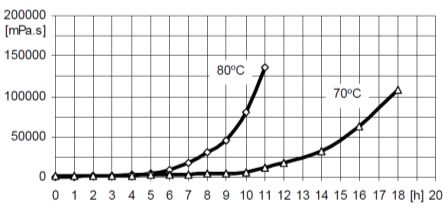
Fig.4.1: Viscosity increase at 70°C and 80°C (Measure with Brookfield)
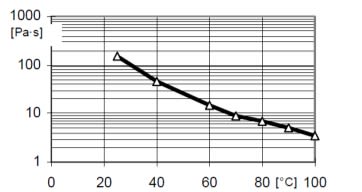
Fig.4.2: Initial viscosity in function of Temperature (Measure with Rheomat 115, D = 10S-1)
Gelation/Cure Time
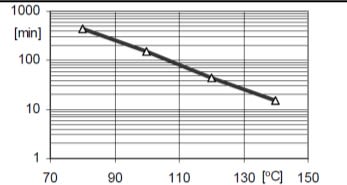
Fig.4.3: Geltime measured in function of temperature (Measure with Gelnorm Instrument / ISO 9396)
Mechanical and Physical Properties
Key Value Unit Test Method Condition Tensile strength 80 - 90 N/mm² ISO R 527 Determined on standard test specimen at 23°C, Cured for 4h at 80°C + 10h at 140°C
Elongation at break 1.0 - 2.0 % ISO R 527 Determined on standard test specimen at 23°C, Cured for 4h at 80°C + 10h at 140°C
E-Modulus from tensile test 10,000 - 12,000 N/mm² ISO R 527 Determined on standard test specimen at 23°C, Cured for 4h at 80°C + 10h at 140°C
Flexural strength 130 - 140 N/mm² ISO 178 Determined on standard test specimen at 23°C, Cured for 4h at 80°C + 10h at 140°C
Surface strain 1.3 - 1.5 % ISO 178 Determined on standard test specimen at 23°C, Cured for 4h at 80°C + 10h at 140°C
E-Modulus from flexural test 10,000 - 12,000 N/mm² ISO 178 Determined on standard test specimen at 23°C, Cured for 4h at 80°C + 10h at 140°C
Compressive strength 185 - 195 N/mm² ISO 604 Determined on standard test specimen at 23°C, Cured for 4h at 80°C + 10h at 140°C
Critical stress intensity factor (KIC) 2.7 - 2.9 MPa·m¹/² CG 216-0/89 Determined on standard test specimen at 23°C, Cured for 4h at 80°C + 10h at 140°C
Specific energy at break (GIC) 550 - 650 J/m² CG 216-0/89 Determined on standard test specimen at 23°C, Cured for 4h at 80°C + 10h at 140°C
Heat distortion temperature (HDT) 80 - 90 °C ISO 75 Determined on standard test specimen at 23°C, Cured for 4h at 80°C + 10h at 140°C
Glass transition temperature (DSC) 80 - 90 °C IEC 1006 Determined on standard test specimen at 23°C, Cured for 4h at 80°C + 10h at 140°C
Coefficient of linear thermal expansion 30 - 35 × 10⁻⁶ K⁻¹ DIN 53752 Determined on standard test specimen at 23°C, Cured for 4h at 80°C + 10h at 140°C
Thermal conductivity 1.00 - 1.10 W/mK ISO 8894-1 Determined on standard test specimen at 23°C, Cured for 4h at 80°C + 10h at 140°C
Glow resistance Class 2b DIN 53459 Determined on standard test specimen at 23°C, Cured for 4h at 80°C + 10h at 140°C
Flammability (Thickness of specimen: 4 mm) Class HB UL 94 Determined on standard test specimen at 23°C, Cured for 4h at 80°C + 10h at 140°C
Thermal ageing class (20000h) Class H IEC 60085 Determined on standard test specimen at 23°C, Cured for 4h at 80°C + 10h at 140°C
Water absorption (specimen: 50×50×4 mm) (10 day at 23°C) 0.10 - 0.15 % by wt ISO 62 Determined on standard test specimen at 23°C, Cured for 4h at 80°C + 10h at 140°C
Water absorption (specimen: 50×50×4 mm) (60 min at 100°C) 0.10 - 0.20 % by wt ISO 62 Determined on standard test specimen at 23°C, Cured for 4h at 80°C + 10h at 140°C
Water absorption (specimen: 50×50×4 mm) (10h at 100°C) 0.40 - 0.50 % by wt ISO 62 Determined on standard test specimen at 23°C, Cured for 4h at 80°C + 10h at 140°C
Water absorption (specimen: 50×50×4 mm) (100h at 100°C) 1.50 - 2.00 % by wt ISO 62 Determined on standard test specimen at 23°C, Cured for 4h at 80°C + 10h at 140°C
Density (Filler load: 60% by wt.) 1.8 - 1.9 g/cm³ DIN 55990 Determined on standard test specimen at 23°C, Cured for 4h at 80°C + 10h at 140°C
Electrical Properties
Key Value Unit Test Method Condition Breakdown strength (IEC 60243-1) 20 - 21 kV/mm IEC 60243-1 Determined on standard test specimen at 23°C, Cured for 4h at 80°C + 10h at 140°C
Diffusion breakdown strength (DIN/VDE 0441/1) Class HD 2 DIN/VDE 0441/1 Determined on standard test specimen at 23°C, Cured for 4h at 80°C + 10h at 140°C
Specimen temperature after test ≤ 23 °C N/A Determined on standard test specimen at 23°C, Cured for 4h at 80°C + 10h at 140°C
HV arc resistance 183 - 185 sec ASTM D 495 Determined on standard test specimen at 23°C, Cured for 4h at 80°C + 10h at 140°C
Tracking resistance (with solution A) CTI >600-0.0 IEC 60112 Determined on standard test specimen at 23°C, Cured for 4h at 80°C + 10h at 140°C
Tracking resistance (with solution B) CTI >600M-0.0 IEC 60112 Determined on standard test specimen at 23°C, Cured for 4h at 80°C + 10h at 140°C
Electrolytic corrosion Grade A-1 DIN 53489 Determined on standard test specimen at 23°C, Cured for 4h at 80°C + 10h at 140°C
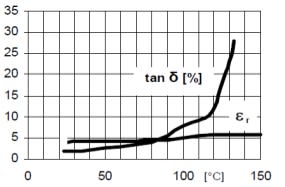
Figure 5.1: Loss factor and dielectric constant in function of temperature (frequency: 50Hz / IEC60250)
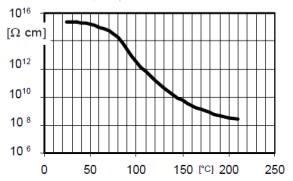
Figure 5.2 Volume resistivity in function of temperature (measurement voltage: 1000V / IEC60093)
Special Properties
Thermal Endurance Profile acc. IEC 60216 (cured for 4h at 80°C and 10h at 140°C)
Investigated property : Flexural strength (ISO 178/93)
Selected end point : 50% of initial value (129.6MPa)
T I (100000h/10000h) 185/232°C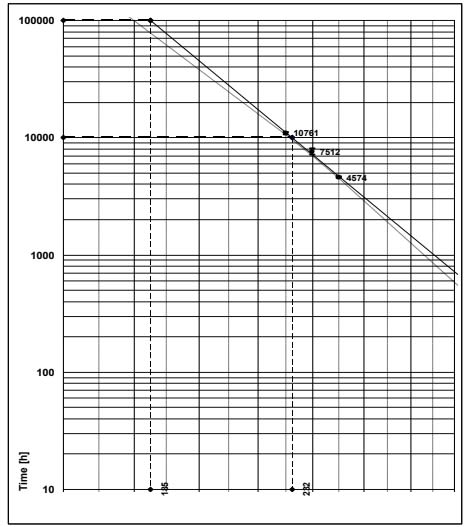
Fig. 7 With the high temperature index given above the materials qualify for use in systems with a thermal class of 180°C. This makes it suitable for designing and producing of class H cast resin distribution transformers.
- Application Information
Dry-type distribution transformers, glass fiber reinforced.
Properties
Other
- Application Information
Value Units Test Method / Conditions Mix Ratio 3.5 %(W) %(W) Filler : Resin Mix Ratio 0.8 %(W) %(W) Hardener : Resin - Physical Properties
Value Units Test Method / Conditions Glass Transition Temperature (Tg) 85.0 °C °C
